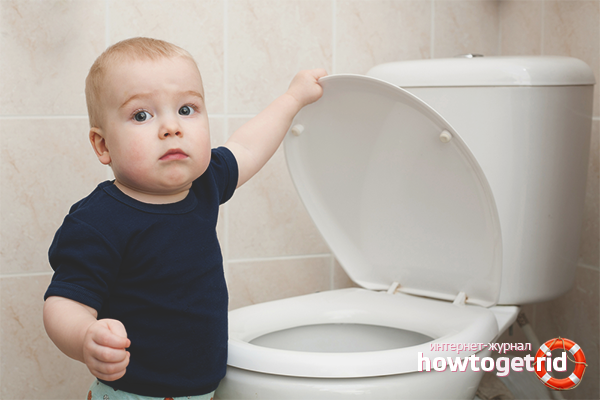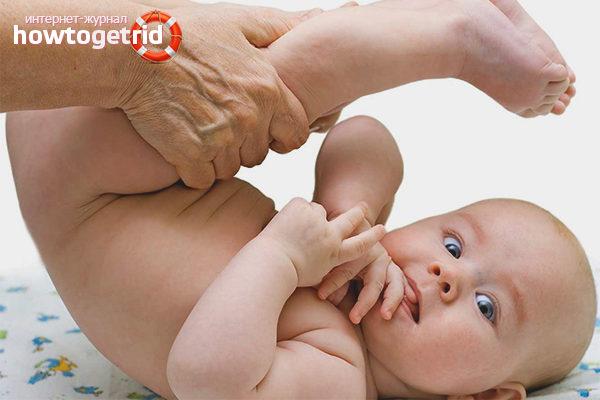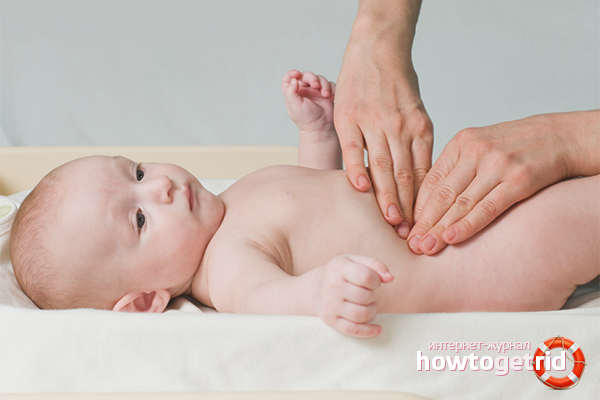The content of the article
The child did not go to the toilet for more than 2 days and complains of abdominal pain or bloating? Do feces floating in a pot or toilet resemble goat feces? Are they hard and dry, dark in color? Bloody streaks visible in feces? The baby has symptoms of constipation, due to which the child becomes restless and moody. Do bowel movements occur regularly? Need a pediatrician consultation. If constipation is a rare occurrence, you can get rid of it yourself.
Baby and lactating woman's diet
The work of the children's intestines directly depends on the food that he has to digest. The diet of the baby consists of mother's milk, therefore, with constipation and flatulence in a baby, a nursing woman is recommended to refuse:
- from carbonated and alcoholic drinks;
- whole milk and legumes;
- do not eat white cabbage in raw form;
- remove spices from the diet;
- replace fried foods with steamed or stewed ones.
From 3-4 months, the baby is given boiled water to normalize bowel function. First, a tablespoon per day or slightly less. After the introduction of the first feeding, the amount of liquid is increased to 50–80 ml.
Babies who use mixtures instead of breast milk are recommended to buy the same brand. If you constantly experiment with artificial nutrition and change the manufacturer every week, the digestive tract will be disrupted. The intestines do not have time to adapt to the new composition, and constipation occurs.
Babies who were breastfed are transferred to artificial mixtures gradually. First, mother's milk and a synthetic drink are combined so that the baby’s digestive tract is used to the new supplement. And gradually replace the mixture with the usual food.
If it was not possible to smoothly switch to "milk" from the package, the baby must be given boiled water. Mixtures are usually more nutritious and thicker than a natural product, so the intestines need extra fluid to digest them.
Menu for babies from 1-2 years
Constipation occurs with the introduction of complementary foods, when parents give preference to protein or too fatty foods. The first "adult" food that the baby should try is stewed vegetables. Zucchini or pumpkin, carrot or broccoli will do. Further, the child is introduced to oatmeal, wheat or barley porridge. Rice with a tendency to constipation is prohibited, because it has fixing properties.
Gradually, meat, fruits, fish, cottage cheese and dairy products appear in the baby's diet. Mom boils or stews vegetables, boils jelly and stewed fruit, prepares casseroles and soups. If you correctly compose the menu, give the child enough fluid and not stuffed with sweets and smoked meats, he may not know about the existence of constipation.
Bowel obstruction caused by stress, taking antibiotics or a cold will eliminate:
- vegetable salad seasoned with olive oil;
- boiled or raw beets;
- some fresh plums;
- teas from rose hips, which are recommended to add 20 g of honey;
- beetroot soup or vegetable broth soup;
- prunes and dried apricots;
- wholemeal bread from rye flour;
- peeled apples;
- boiled turkey, chicken or sea fish.
A baby who has constipation should not be given:
- any sweets except honey;
- fatty meat, such as duck or pork;
- puff pastry and white bread;
- cocoa and jelly;
- canned vegetables, fish or meat;
- smoked meats and spicy seasonings.
Such a diet is suitable for children of all ages who have switched from breastfeeding or artificial feeding to regular food. Do intestines work after taking antibiotics? The child should be given kefir, fermented baked milk or yogurt without sugar and flavorings. Dairy products populate the digestive tract with beneficial bacteria, therefore intestinal motility improves, and constipation disappears.
Physical exercise
With a child who has flatulence and stagnation of feces, they do simple exercises. Exercises are performed in the morning, 2 hours before a meal or 3-4 after breakfast or lunch. With constipation, the child can not be heavily overloaded, just stir it up a bit and run intestinal motility. Recommended:
- tilts in different directions and back and forth;
- squats and walking on all fours;
- exercise "bicycle", which is done while lying on your back;
- jumping on the right or left foot for 10 seconds;
- swings with bent or straight lower limbs.
Does the child not want to stretch and squat? Perhaps he will like to ride a bicycle or jump rope, collect beads scattered on the floor, or toys. Any physical activity is welcome.
Constipation makes the baby lethargic and sleepy, but the larger it lies or sits on the couch, the slower the intestines work. With constipation, it is important to stir up the child and interest in outdoor games.
Babies who cannot walk are advised to ride a large rubber ball. Cover the inventory with a warm sheet or towel, put the baby belly down and swing left-right or back-and-forth. Thanks to this massage, the gases escape, and the baby's intestines are cleaned of stagnant feces.
Peristalsis of the digestive organs improves and special exercises:
- Put the baby on a hard surface.
- The child is turned upside down. Mom takes one leg and gently presses it to the navel.
- Return the lower limb to its original position, repeat with the second.
- Press both legs to the stomach, stay in this position for 5-10 seconds.
- Make exercise "bike": raise the lower limbs of the baby, simulate riding a two-wheeled vehicle.
- Raise the right leg, bend it and try to reach with the knee to the left elbow. Make sure that the child is comfortable and not hurt. Repeat with left knee and right elbow.
Before morning exercises, the baby is recommended to give a little non-carbonated water: for infants a tablespoon, for children from 3-4 years old, 100-200 ml. Physical activity in combination with a fluid is one of the best ways to get rid of constipation.
Massage
For problems with bowel movements, it is helpful to massage your stomach. First, stroke it clockwise, slightly pressing in the navel, after stretching the oblique abdominal muscles. The fingers move from the center of the abdomen to the sides, flexing and dispersing the blood.
You do not need to put too much pressure on the abs and intestines, otherwise the child will experience discomfort. Stroking should be light and neat. During the massage, mom is advised to talk with the baby and calm him down. You can quietly hum something or tell a fairy tale.
After stroking the tummy, slightly press with your fingers to stimulate the excretion of feces from the child's body. Repeat the procedure 3-4 times a day:
- after waking the child in the morning or afternoon;
- before dinner;
- 1-2 hours before going to bed.
The duration of the massage is 10-15 minutes. The baby is given a little non-carbonated water before the procedure. Before washing the abdomen, wash your hands with soap and water. Improves finger sliding baby oil or oily cream.
Psychological constipation
Fecal disgust in some babies. The child does not like the color, smell or appearance of excrement, and he begins to slow down the process of defecation.When the baby feels that he wants to go to the toilet, he tries to restrain his natural urges. If this happens regularly, the digestive organs are disrupted, the sensitivity of nerve endings located on the sphincter is reduced, and constipation becomes chronic.
Other children do not want to go to the toilet with strangers. They endure and refuse to sit on the pot if grandmother or aunt can enter the bathroom at any time, or parents put the pot in the middle of the hall where strangers are.
Some babies inhibit bowel movements due to fear that will again hurt. They remember the discomfort from the previous constipation, so they are restrained to the last.
How to help a child in such a situation? Talk and explain that:
- Now it won’t hurt, because the baby’s feces have a normal consistency, and the priest has already healed.
- There is nothing wrong with excrement, these are the natural secretions of the body.
- After the toilet, you can wash your hands so that they smell like soap, not feces.
- Tolerate and not to go to the toilet is very harmful.
Shy kids need to create comfortable conditions:
- Put a pot in the back room, where no one enters.
- Show how the bathroom door closes, and say that no one can disturb him.
- Take home if the child cannot go to the toilet at a party.
The kid should not be scolded if he endured for a long time or was very shy, and therefore poked in his pants. Mom can show that she is upset or saddened, or say that big boys or girls are asking for a pot. But it is forbidden to beat or scream at the child, otherwise it will injure him even more.
Folk remedies
Breasts up to 4–5 months of age with constipation are given only dill water or fennel infusion. Other drinks and products are contraindicated. Children older than 8–9 months old are allowed a decoction of dried apple slices or cherries.
Prune infusion is useful: cut the workpiece into small pieces and pour hot water, after 15 minutes, separate the liquid from the sediment and drink the child. Give 15–20 ml of medication at a time.
Natural juices are recommended to one year old kids and older:
- orange;
- cabbage;
- carrot;
- peach;
- grape
- apricot.
Before the meal, the child is given mashed fresh cucumber to stimulate intestinal motility. Vegetables cannot be combined with yogurts, kefir, fermented baked milk, cottage cheese, artificial mixtures and mother's milk.
Flaxseeds will help children with lazy bowel syndrome. The product, ground into powder, is added to cereals and vegetable purees. Decoctions of flaxseed are prepared: pour 20 g of boiling water, insist in a thermos or jar wrapped in a towel. Babies are given 25–35 ml, and children from 11-12 years old 50-60 ml.
A child who loves salty foods is given pickled cabbage pickle. 4-5 teaspoons per day. Ground peas are also useful: eat 20 g of crushed product before breakfast, washed down with boiled water.
Enema and medicines for constipation
The child suffers, but folk methods do not help? Glycerin suppositories, which are injected into the rectum, will relieve constipation. Infants need only half of the suppository, and children from 6-7 years old can be a whole.
The digestive tract will be improved by preparations containing lactulose:
- Dinolac;
- Prelax;
- Lactusan
- Dufalac.
Constipation caused by dysbiosis or changes in the diet, remove the enema. In a rubber pear, collect 50-150 ml of water, into which a spoon of glycerin or chamomile broth is added. Lubricate the tip with petroleum jelly or a fat cream, inject into the rectum of the baby and slowly squeeze out the liquid. Lift the baby's pelvis and squeeze the buttocks so that the water does not flow out immediately, but after 5-10 minutes.
Too often it is impossible to resort to an enema, otherwise the intestine will forget how to empty itself without assistance, and serious problems with bowel movements will begin.
The causes of constipation in children are different: from harmful products to diseases of the digestive organs. If stool stagnates regularly, and the problem is accompanied by other suspicious symptoms, you should consult a gastroenterologist and choose a treatment.
Video: how to help your child poke around without an enema and tubule













Submit